Salt Free Anti-Scale Water Softener 15 GPM + Whole House Catalytic Carbon Filter
Salt Free Anti-Scale Water Softener 15 GPM + Whole House Catalytic Carbon Filter
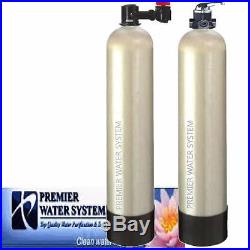
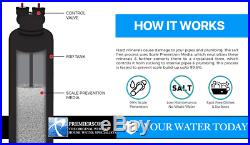
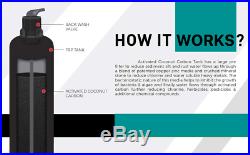
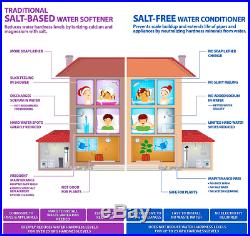
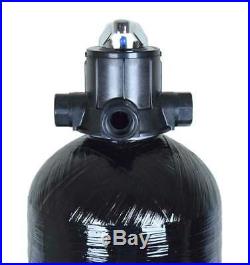

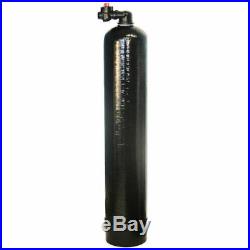

SALT FREE WATER CONDITIONER 15 GPM + Whole House CATALYTIC CARBON FILTER MANUAL VALVE WHOLE HOUSE SYSTEM. Salt Free System: SCALE REDUCTION MEDIA. 10″ X 54″Mineral Tank (Black or Blue). MANUAL BACK WASH VALVE Distribution Tube Catalytic Carbon media 1.5 cu ft. NO Salt Water Conditioning. Scale Prevention System (New Technology). NO lime scale build-up on pipes, fixtures or appliances and can even remove existing scale in some cases! Easy Installation, Two Connections, Simple pipe in /pipe out! Saves water no backwash required simple flow through to point of use! NO power required NO timer or backwash cycle! NO chemicals or salt required! Will not harm the environment; adds or removes nothing from the water while giving the benefits of soft water! The essential calcium and magnesium nutrients removed by traditional water softeners remain and there is no sodium added as with traditional softeners to aggravate cardiovascular or other health problems. 50% less soap and detergents required and enjoy whiter whites and brighter colors without hard water stains! Fits in limited space one small tank no brine tanks or large regeneration tanks! Calcium ions, magnesium ions and bicarbonate ions in untreated water form scale on the inside walls of pipe, exterior of fixtures and on heating surfaces because crystallization is not taking effect efficiently between the ions due to their suspension between water molecules and the need to come together in the proper alignment to form crystals. Therefore they form as scale on the surfaces of the water system. The system is a simple physical water treatment known as TAC (Template Assisted Crystallization) Template=mold, guide or pattern. Assisted=Help or make easy. Crystallization=Form a definite shape. Inside the TAC treatment tank are porcelain beads with the atomic level pattern of the crystal etched on their surface allowing for the calcium, magnesium and bicarbonate ions to come together on the template to created millions of microscopic crystals of scale that rapidly form and are released from the bead immediately into the treated water, not forming on the contact surfaces of the water system and are carried downstream in suspension through the water system. The crystal formation on the microscopic crystals (seed crystals) created on the beads and released in the water stream are the lowest energy reaction possible between the ions therefore existing scale will be dissolved back into the water stream by reacting with and forming crystals. The seed crystals are constantly being formed on the beads and released as catalyst for crystal growth in the water steam. Crystallization is the process that the magnet process and electrical charging of water claim to achieve. But by independent testing the electrical and magnetic methods are a maximum of 60% effective at scale prevention leaving an unacceptable level of 40% scaling. The TAC method is tested at 99.9% efficient at scale prevention and removal. Whole House 10″ X 54″ Carbon Whole House Filter. 1.5 cu ft. MANUAL BACK WASH VALVE. Carbon is a substance that has a long history of being used to absorb impurities and is perhaps the most powerful absorbent known to man. One pound of carbon contains a surface area of roughly 125 acres and can absorb literally thousands of different chemicals. Activated carbon which has a slight electro-positive charge added to it, making it even more attractive to chemicals and impurities. In general, basic activated carbon itself has some catalytic activity due to the presence of a small number of chemical functionalities present on the corners of its graphitic basal plane. To enhance the catalytic activity of carbon, the surface is modified by a chemical process in which the electronic structure of the carbon is altered in such a manner that the resulting carbon offers enhanced catalytic capability. As a result, the catalytic carbon produced by this method is not only rich in chemisorption, but also physisorption capacity. Many water utilities across the U. Are transitioning to chloramine for disinfection as an alternative to chlorine. This change is in response to stricter U. Environmental Protection Agency regulations on disinfection byproducts (DBPs), which are created when chlorine reacts with organics in water. Chloramine, a combination of chlorine and ammonia, is more stable and does not create DPBs. Removing chloramine at the point of use, however, is more difficult than removing chlorine. Standard granular activated carbon (GAC) and carbon block products have limited capacity for chloramine reduction. Products known as catalytic or surface-modified activated carbon can provide a solution. In general, the catalytic properties of carbon are measured by the rate at which carbon decomposes hydrogen peroxide. The resulting peroxide number, measured in minutes, estimates the carbons utility in any catalytic application, including chloramine reduction. Based on the comparative results obtained for different mesh size commercial carbons, the efficiency of chloramine reduction is discussed in the terms of peroxide decomposition capacity and further extended to the total life (volume) claims for corresponding GAC cartridge and carbon block. The two most important factors affecting the efficiency of activated carbon filtration are the amount of carbon in the unit and the amount of time the contaminant spends in contact with it. The more carbon the better. Similarly, the lower the flow rate of the water, the more time contaminants will be in contact with the carbon, and the more absorption that will take place. Particle size also affects removal rates. The most common carbon types used in water filtration are bituminous, wood, and coconut shell carbons. While coconut shell carbon typically costs 20% more than the others, it is generally regarded as the most effective of the three. All of our activated carbon filters use coconut shell carbon. It has very few moving parts and easy to use. When you need to backwash a filter, you put in into the backwash cycle for 10 minutes, followed by a rinse of 3 minutes, and then back into the service mode. That is all there is to it! Once a week schedule for backwashing is generally sufficient. For a more economical product and ease of use, we recommend you get this rather then opting for unit that does not backwash. Benefits and Importance of a Backwash Cycle. As filter operates in service mode, it collects particles in the filter bed. Also, since water’s nature is to follow the path of least resistance, after a time it begins to cut channels through the medium. As channels or holes in the media bed forms, water begins to flow around rather through the medium. This process is called “channeling” and it reduces the effectiveness of the filter considerably. The backwash is accomplished by sending the water down the riser tube from which it enters the filter tank at the bottom. The force of the water is such that it actually lifts the media bed, swirling and tossing the granular medium. The water leaves the filter tank through the control valve, which routes it through the filter’s drain line. Particles that were in the bed are washed to drain. The backwash is an intense rinsing and tossing of the medium that lasts for several minutes. In a standard residential filter, a typical backwash lasts about ten minutes. After the backwash, initiate a “rinse” of the bed during which water flows downward through the medium, up through the distribution tube and out the drain. The purpose of this rinse is to rinse and settle the bed and prepare it for return to service flow. A regular backwash schedule maintains the efficiency of the filter, as well as providing cleaner water. However we are not responsible for transit time and delays. Uncompromising Quality Water Systems. We have years of experience crafting our solutions for specific water sources in California. Our whole house water systems is designed to give you the best water quality from every faucet in your home. Setting ourselves apart from the competition, we use a three stage water system to clean, soften, and purify your water. A whole house filter, softener, and a reverse osmosis system. WEEKEND BY APPOINTMENT ONLY. Track Page Views With. Auctiva’s FREE Counter. The item “Salt Free Anti-Scale Water Softener 15 GPM + Whole House Catalytic Carbon Filter” is in sale since Saturday, June 6, 2015. This item is in the category “Home & Garden\Home Improvement\Plumbing & Fixtures\Water Filters”. The seller is “dhillonnoni” and is located in Canyon Country, California. This item can be shipped to United States.
- Brand: PREMIERSOFT
- Model: WHSP15WHCC1.5FTMFV
- Type: Water Filter
- Country/Region of Manufacture: United States
- SALT FREE CONDITIONER: SOFTENER ALTERNATIVE
- WHOLE HOUSE: CHLORAMINE REDUCTION
- MPN: WHSP15WHCC1.5FTMFV
- Filter Type: Water Softeners
